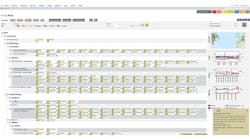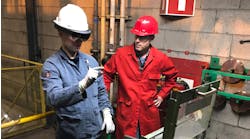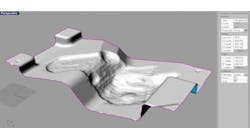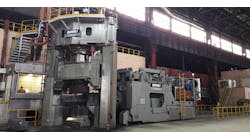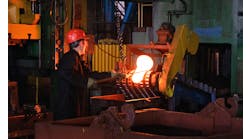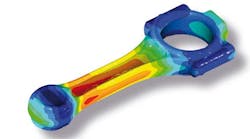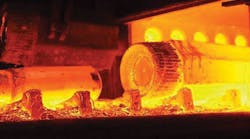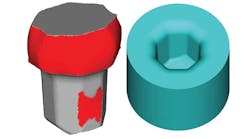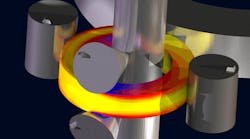Promising Faster, More Functional Simulation, with Real Advantages
Simulation software has gained adherents and appreciation at forging operations over the past decade, as we have documented each year in our annual survey of operators and executives. That is certainly due to the highly focused functions that simulation software authors have developed specifically for heating and forming components — as well as to the frequency of their new development rollouts and the flexibility of their technology.
The availability of these platforms has made work more efficient, processes more reliable, and products better. In our most recent FORGING Business Outlook survey, 33.7% of respondents confirmed their use of simulation as part of their design process, including to reduce shop-floor trials and to optimize forging processes; and 3.7% indicated their use of simulation is limited to performing post-forging analysis. A much larger cohort, 55.6%, indicated they use simulation for both applications.
But, even after a decade or so of technological progress, our latest survey revealed that less than 50% of forging executives and operators have adopted simulation for their forging programs; 53.6% indicated they do not uses such technology at all. Among those un-persuaded forgers, the cost of simulation software is a factor for some (26.7%), but others (20%) claim the technology provides no value to their operations. That view may have to be adjusted.
Following a wider trend in the manufacturing software field, multidiscipline analysis and simulation program developer MSC Software is buying forging-simulation specialist Simufact Engineering, a combination that will bring more functional resources into the purview of forging operations. The value of the acquisition was not announced.
MSC Software describes itself as one of the “ten original software companies and the worldwide leader in multidiscipline simulation.” It’s used in academic and industrial research, as well as manufacturing. Some of the brand names for its programs include Simulating Reality, MSC Nastran, Adams, Actran, Digimat, Dytran, Easy5, Marc, Patran, MasterKey, MasterKey Plus, Mvision, SimDesigner, SimManager, and SimXpert.
Simufact has two primary simulation platforms, Simufact.forming and Simufact.welding, based on “nonlinear simulation software technology.” These programs are used by OEMs and their Tier suppliers in aerospace, automotive, and machinery industries, to achieve production-cost savings by reducing shop-floor trials.
Simufact.forming software is used to simulate hot forging, cold forming, sheet metal forming, rolling, ring rolling, open-die forging, mechanical joining, heat treatment, and welding. It has more than 500 industrial customers, according to the developers.
“It is tremendously exciting to make the leap to a global company,” offered Michael Wohlmuth, co-founder and CEO of Simufact.
MSC noted that Simufact’s forging customers have reduced physical testing up to 50% using the software, and confirm that cycle times for new part developments in some cases have been reduced from three weeks to one week.
“Too often, our customers tell me that poorly-understood manufacturing processes result in products that don’t function as designed and simulated,” observed MSC Software president and CEO Dominic Gallello. “By connecting Simufact’s manufacturing process oriented tools to design simulation, we can better assist our customers with their drive for ‘first time right’.”
The Simufact platform will become part of the MSC Software portfolio. What this will mean for Simufact.forming users, and for forgers in general, is “full access to MSC meshing technology,” according to Simufact director of marketing & communications Volker Mensing. “Meshing” is the process of generating a polygonal or polyhedral object that approximates the geometric space to be occupied by the finished forging. The speed and reliability of that sequence is a critical parameter in evaluating the effectiveness of a simulation program.
“Medium-term, this will result in performance benefits,” Mensing explained. “The software will be able to mesh even more complex geometries in shorter time.”
He added that “novelties” formed by MSCs solver development will be available more quickly in Simufact products.
But more than that, Mensing noted that MSC provides available technologies that Simufact.forming user have not had access to before (citing the program’s ability to perform fatigue, damage and material modeling.) Each of these points will result in “a higher potential for innovation flowing into Simufact products,” he anticipates.
Taking a more strategic view, Mensing noted that the Simufact acquisition supports the larger developer’s “design as manufactured” approach. “MSC is able to provide an even more complete range of solutions for product design and (new) manufacturing design now. In many manufacturing companies there is a gap between product design and process design. MSC’s approach helps close this gap.”
“Being a direct member of the MSC family offers additional advantages,” confirmed Dr. Hendrik Schafstall, co-founder and CTO of Simufact added. “We will be able to accelerate the technology development; our customers can look forward to greater innovation.”

